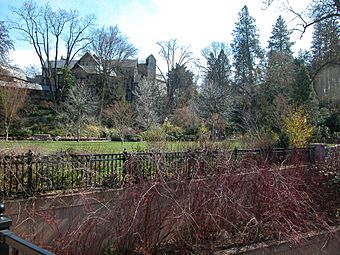Lithia Park facts for kids
Quick facts for kids |
|
|
Lithia Park
|
|

Lithia Park green
|
|
| Location | Ashland, Jackson County, Oregon |
|---|---|
| Area | 93 acres (380,000 m2) |
| Built | 1892 |
| NRHP reference No. | 82001505 |
| Added to NRHP | November 22, 1982 |
Lithia Park is a big and important park in Ashland, Oregon. It covers about 93 acres (that's like 70 football fields!) of beautiful forest and land. The park follows Ashland Creek from the middle of town up towards Mount Ashland.
The park's name comes from "lithia" water. This special water has a natural mineral called lithium in it, and it's pumped into the park.
Lithia Park has many fun things to do. You can find two large grassy areas, a stage for music shows, two duck ponds, and a big playground. There are also tennis courts, community buildings, and an ice skating rink in the winter. Plus, you can enjoy picnic spots and miles of hiking trails.
The park was added to the National Register of Historic Places in 1982. It also has a peaceful Japanese garden.
Contents
Park History: How It Started
The area where Lithia Park is now used to be home to an old flour mill. This mill was built in 1852 by Abel Helman and Eber Emery. It was one of the first buildings in what became the city of Ashland. Over time, the mill became old and messy.
A Park for Everyone
Around 1908, a group of women called the Women's Civic Improvement Club wanted to create a park in Ashland. They worked hard to convince the city council. Because of their efforts, the city decided to create a park commission. They also set aside all city land along Ashland Creek to be used as a park.
The Story of Lithia Water
In 1907, a special spring was found nearby. The water from this spring had a lot of lithium in it, which people thought was good for health. A journalist named Bert Greer moved to Ashland in 1911. He thought Ashland should become a place where people could come to enjoy the mineral water. He pushed for the city to spend money to bring this "lithia water" into the park.
In 1914, people voted to approve the money. The park commission hired John McLaren, who designed Golden Gate Park in San Francisco, to help design Lithia Park. They also set up pipes to bring the mineral water into the park.
Changes and Challenges
For a while, there was some disagreement about who should control the park and how money was spent. But in 1916, Ashland residents voted to give control back to the park commission.
In 1915, the park commission even opened a free "auto camp" where people traveling by car could stay. This camp was very popular for many years.
Later, interest in the mineral water resort faded. However, the park continued to improve. In 1937, Chet Corry became the park superintendent. He brought in many native plants and made the park's landscaping even better.
Floods and Rebuilding
Over the years, Lithia Park faced some tough times. In 1974, a big flood caused a lot of damage. People in Ashland voted again to provide more money to fix the park.
Another major flood happened in 1997. This flood also damaged the park and the downtown area. After this, a lot of work was done to strengthen Ashland Creek and the park's bridges. This work helped prevent future disasters. Thanks to these efforts, Lithia Park is now a beautiful and important part of Ashland.
In 2014, the American Planning Association named Lithia Park one of the 10 Great Public Spaces in America.
Images for kids


